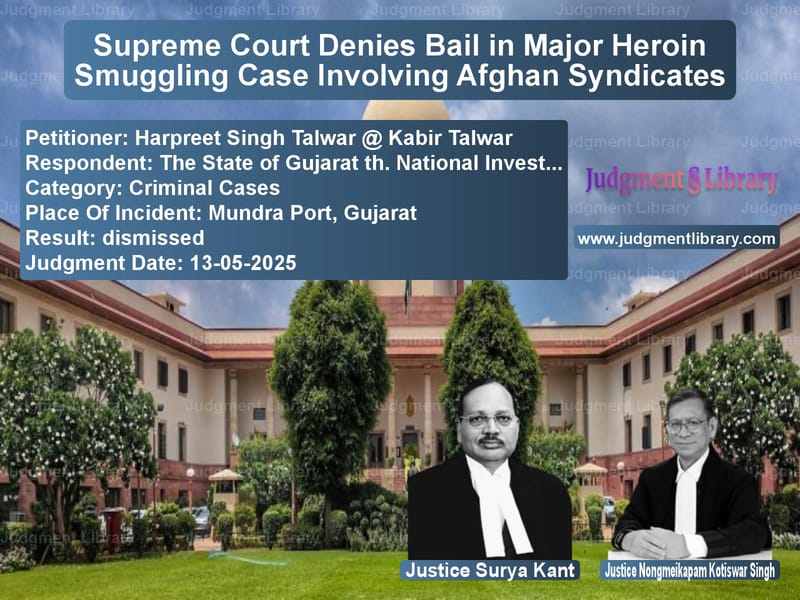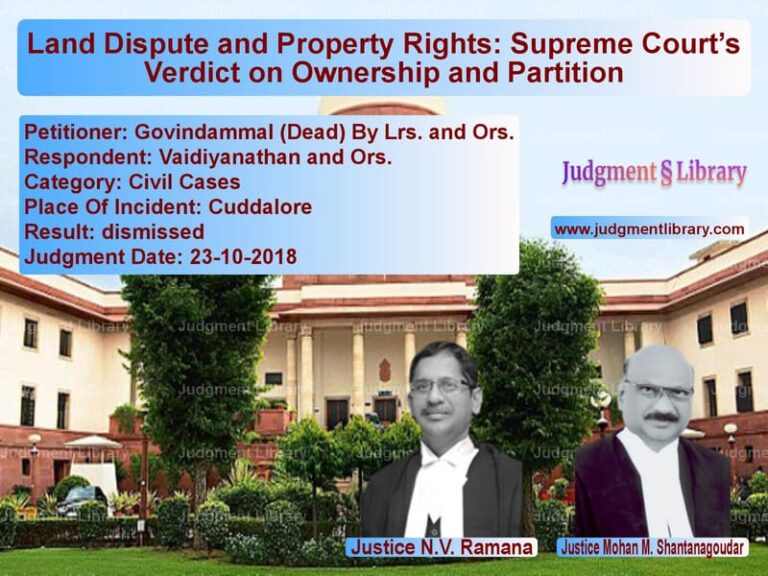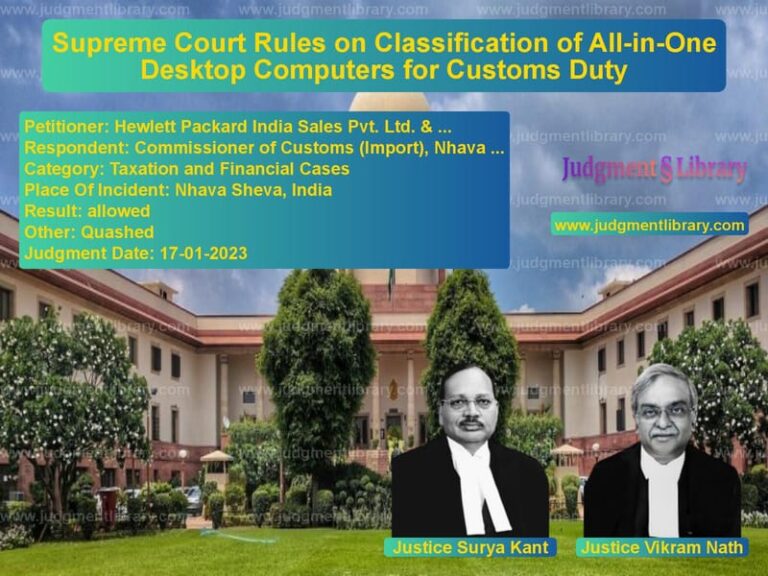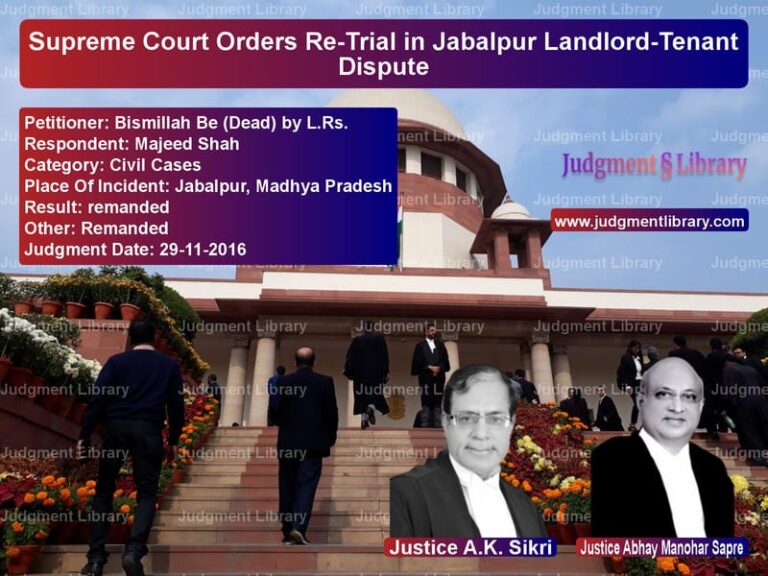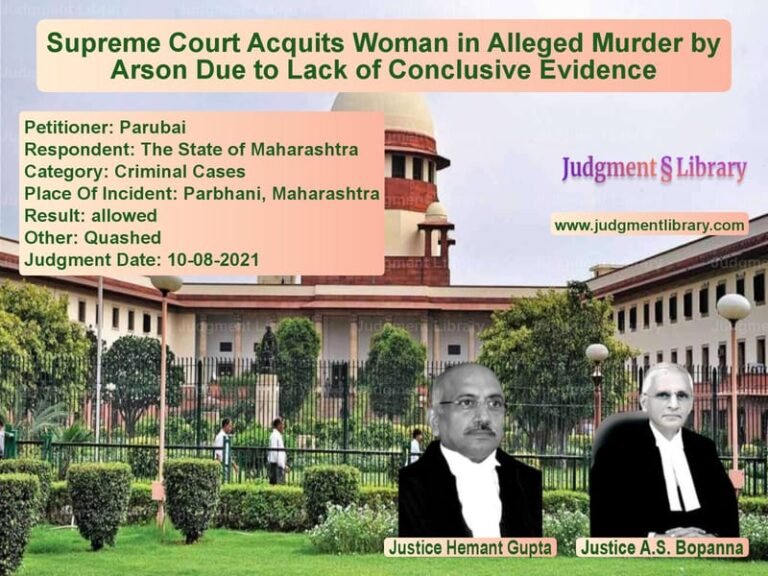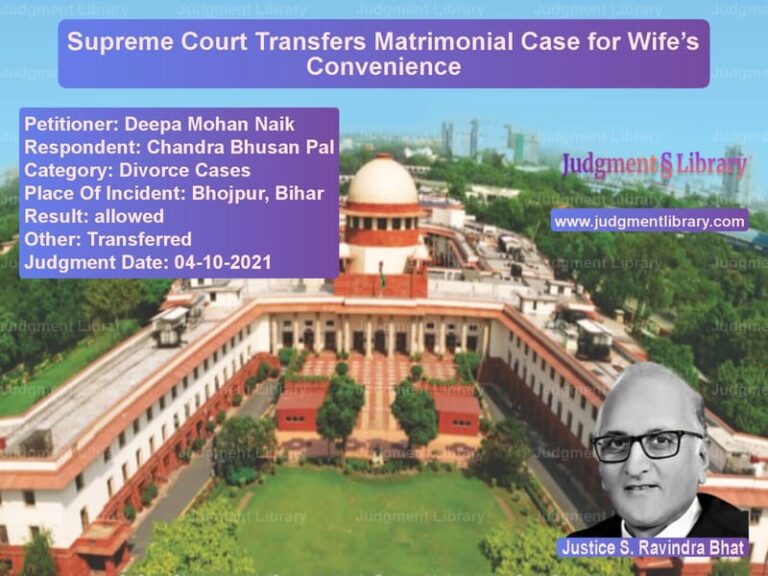Supreme Court Denies Bail in Major Heroin Smuggling Case Involving Afghan Syndicates
In a significant ruling that underscores the seriousness of transnational drug trafficking, the Supreme Court has denied bail to Harpreet Singh Talwar, an accused in one of India’s largest heroin smuggling cases. The appellant, who has been in custody since August 2022, is alleged to have played a central role in facilitating the import of heroin-laced talc stones through Gujarat’s Mundra Port under the cover of legitimate commercial imports. The case, investigated by the National Investigation Agency (NIA), involves a sophisticated international narcotics operation with links to Afghan-based syndicates and represents one of the most substantial drug seizures in Indian history.
The legal battle reached the Supreme Court after both the Special Court and Gujarat High Court had rejected Talwar’s bail applications. The appellant is charged under multiple sections of the Narcotic Drugs and Psychotropic Substances Act (NDPS Act), the Unlawful Activities (Prevention) Act (UAPA), and the Indian Penal Code for his alleged involvement in a conspiracy that saw nearly 3,000 kilograms of heroin smuggled into India with an estimated market value exceeding ₹21,000 crores. The Court’s decision highlights the complex balance between individual liberty and national security concerns in cases involving organized international crime.
The Elaborate Smuggling Operation
The case originated when the Directorate of Revenue Intelligence (DRI) seized 2,988.21 kg of heroin from a consignment that had arrived from Afghanistan via Iran. The narcotics were concealed as talc powder in shipments addressed to various Indian companies. Investigations revealed an elaborate network of shell companies, fake documentation, and sophisticated smuggling techniques designed to bypass customs checks while moving massive quantities of drugs into the country.
According to the prosecution, Talwar’s involvement began in September 2020 when he traveled to Dubai and was introduced to Vityash Koser @ Raju Dubai, a foreign national described as being at the helm of the transnational heroin smuggling network. This meeting allegedly laid the foundation for a criminal conspiracy where Talwar agreed to facilitate heroin imports under the guise of legitimate commercial goods. The prosecution claims that Talwar instructed his accountant to register a proprietorship concern named M/s Magent India in the name of his employee, Prince Sharma, which then became the vehicle for importing the contraband.
In December 2020, a consignment of 22 bags of semi-processed talc weighing 21,880 kilograms was dispatched from Afghanistan consigned to M/s Magent India. The shipment arrived at Mundra Port on December 23, 2020, and was cleared after examination. The NIA alleges that no payment was made to the Afghan supplier; instead, Talwar received perfumes, dry fruits, and footwear as barter compensation through other firms controlled by him.
The Legal Arguments for Bail
Before the Supreme Court, senior counsel for the appellant made several compelling arguments seeking bail. They contended that “the accusations against the Appellant rest solely on circumstantial material, and no direct, primary, or even credible indirect evidence has been adduced against him over the course of investigation or trial proceedings so far.” The defense emphasized that “while 20 vulnerable witnesses have already been examined, not one of them has implicated the Appellant in any manner, and no evidence has emerged linking him to any consignment that was actually found to contain contraband.”
The appellant’s counsel pointed out that “the only consignment associated with the Appellant was imported through M/s Magent India, received on 23.12.2020, declared as semi-processed talc stones originating from Afghanistan, and duly cleared by Customs after being subjected to 100% inspection, as per the statement of Customs Officer (PW10).” They argued that “the prosecution’s theory of guilt is constructed in hindsight on the basis of ‘reverse engineering’, relying on a later consignment found in September 2021, nearly one year after the Appellant’s import.”
The defense also challenged the evidentiary value of the alleged telephonic conversations, stating that “the allegation of five telephonic calls between the Appellant and co-accused Raju Dubai is insufficient to establish criminal conspiracy as while his purported interaction with Raju Dubai may reflect bad judgment, it cannot automatically translate to culpability, especially when no forensic link or recovery connects him to heroin.” They further noted that “the Appellant’s business is Delhi-based and has been operating in the import-export sector for over 15 years, and he has no prior convictions under the NDPS Act or UAPA—thus proving that he is not a flight risk.”
The Prosecution’s Counter-Arguments
Additional Solicitor General Ms. Aishwarya Bhati, representing the NIA, presented a starkly different picture of Talwar’s involvement. She argued that “the Appellant was not merely an incidental actor but a key facilitator in some of the six major consignments, which collectively formed the architecture of what has since been recognised as one of the largest heroin seizures in Indian history.” The prosecution maintained that “M/s Magent India was a front company created by the Appellant immediately after his first meeting with Raju Dubai in September 2020.”
The NIA emphasized that “although no contraband was recovered from the Appellant’s consignment, the absence of physical recovery is not fatal to the case of criminal conspiracy under the UAPA and NDPS Act—which is made out from the Appellant’s meetings abroad, telephonic calls, alleged coordination through protected witnesses, and attempt to obfuscate documentary trails.” This argument sought to establish that the case was built on patterns of behavior and coordinated actions rather than direct physical evidence.
Perhaps most compellingly, the prosecution highlighted that “the death of a key witness under suspicious circumstances on the day he was to record a judicial statement, apart from the fact that two critical witnesses remain untraceable, are clearly indicative of the risk of witness elimination or influence should the Appellant be enlarged on bail.” This pointed to the ongoing threats to the judicial process and the potential dangers of releasing the accused at this stage of the trial.
The Court’s Legal Analysis
The Supreme Court began its analysis by examining the scope of Section 43D(5) of the UAPA, which imposes strict conditions for granting bail in cases under the anti-terror law. The Court noted that “the rigour of Section 43D(5) of the UAPA would, however, in an appropriate case yield to the overarching mandate of Article 21 of the Constitution, especially where the trial is inordinately delayed or where the incarceration becomes punitive. However, such relaxation cannot possibly be automatic and must be evaluated in light of the specific facts and risks associated with each case.”
After careful consideration of the evidence and arguments, the Court concluded that “despite no direct recovery of contraband effected from the Appellant, the Prosecution’s case is that he played a coordinating and enabling role in facilitating the import of narcotics concealed as talc through M/s Magent India—which he allegedly controlled through a proxy. The consignment, although not seized with heroin, shares structural and logistical similarities with those where heroin was ultimately found.”
The Court identified several key factors supporting the prosecution’s case: “The charge against the Appellant must also be evaluated in light of the broader matrix of facts, including (i) his alleged meetings in Dubai with a principal foreign accused; (ii) the transfer of documents through intermediaries for the clearance of a flagged consignment; (iii) efforts to retrospectively fabricate invoices and assign responsibility to others; (iv) the use of multiple firms allegedly connected to him to obfuscate the true nature of the transactions; and (v) his telephonic calls to certain co-conspirators.”
The judgment acknowledged that “no heroin or narcotic substances were directly recovered from the consignment linked to the Appellant. However, the investigative narrative does not rest solely on physical recovery but proceeds on the basis of conspiracy and facilitation. In such cases, the absence of direct seizure is not dispositive, particularly where there exists a pattern of covert coordination, fictitious entities, and barter-based compensation—features which, according to the prosecution, mark the smuggling architecture employed in the present matter.”
Concerns About Witness Safety and Trial Progress
The Court expressed serious concerns about witness safety, noting that “multiple key witnesses still remain to be examined, and the trial while underway, will take time in completion. Out of 24 most vulnerable or material witnesses, two have died, and two others are untraceable. One of the deceased witnesses, a retired Customs Officer, was found dead on the very day he was scheduled to record his statement under Section 164 CrPC. The risk of witness tampering or elimination—whether directly attributable to the Appellant or not—is a real and present concern that militates against the grant of bail at this stage.”
The Court also considered the appellant’s background, observing that “the Appellant’s criminal antecedents, though not involving prior accusations under the NDPS Act, include multiple DRI and customs proceedings involving smuggling of cigarettes, undervaluation of imports, and alleged complicity in corruption offences. These antecedents are relevant only for the limited purpose of evaluating the Appellant’s propensity to interfere with the process of justice if enlarged on bail.”
Additionally, the Court noted that “NIA has also highlighted that several accused remain absconding, including the primary foreign conspirators. In that context, the Appellant’s foreign travel, overseas connections, and financial capacity cannot be overlooked in evaluating the possibility of flight risk. These are not speculative concerns but flow directly from the Appellant’s prior conduct and profile.”
The Court’s Final Directions
While denying bail at the current stage, the Supreme Court provided specific directions for the future. The Court stated: “We are conscious of the settled principle that pre-trial incarceration should not translate into punitive detention. The Appellant has been in custody since 24.08.2022, and while we do not find that this duration alone warrants bail under the present circumstances, the Appellant shall remain at liberty to renew his prayer for bail after a period of six months, or upon substantial advancement in the trial, whichever is earlier.”
The Court also issued important procedural directions: “The NIA is directed to submit to the Special Court an additional list of witnesses who, in its assessment, are sensitive or material, inasmuch as their testimony may have a direct bearing on the role of the Appellant or other co-accused in the ongoing trial and connected investigation” and “The Special Court is directed to list the matter twice in a month and record the statements of Prosecution witnesses on a continuous and uninterrupted basis.”
In a significant clarification, the Court noted that “it would be premature and speculative to extend the allegations against the Appellant to the domain of terror financing. While the prosecution has invoked provisions of the UAPA and has broadly linked the smuggling enterprise to trans-national syndicates with suspected affiliations, there is no compelling reason to currently link the Appellant and proscribed terrorist organisations, either within or outside the country. The evidentiary foundation to sustain such a grave allegation must be clear and compelling—something that, can be seen only after a substantial portion of evidence is led by both the parties.”
The Supreme Court’s decision represents a careful balancing of individual rights against the compelling state interest in combating international drug trafficking networks that pose significant threats to national security and public health. The ruling underscores the judiciary’s approach to bail in cases involving serious economic offences with transnational dimensions, particularly when tried under special statutes like the UAPA that impose stricter bail conditions.
Petitioner Name: Harpreet Singh Talwar @ Kabir Talwar.Respondent Name: The State of Gujarat th. National Investigating Agency.Judgment By: Justice Surya Kant, Justice Nongmeikapam Kotiswar Singh.Place Of Incident: Mundra Port, Gujarat.Judgment Date: 13-05-2025.Result: dismissed.
Don’t miss out on the full details! Download the complete judgment in PDF format below and gain valuable insights instantly!
Download Judgment: harpreet-singh-talwa-vs-the-state-of-gujarat-supreme-court-of-india-judgment-dated-13-05-2025.pdf
Directly Download Judgment: Directly download this Judgment
See all petitions in Drug Possession Cases
See all petitions in Bail and Anticipatory Bail
See all petitions in Money Laundering Cases
See all petitions in Terrorist Activities
See all petitions in Judgment by Surya Kant
See all petitions in Judgment by N. Kotiswar Singh
See all petitions in dismissed
See all petitions in supreme court of India judgments May 2025
See all petitions in 2025 judgments
See all posts in Criminal Cases Category
See all allowed petitions in Criminal Cases Category
See all Dismissed petitions in Criminal Cases Category
See all partially allowed petitions in Criminal Cases Category

